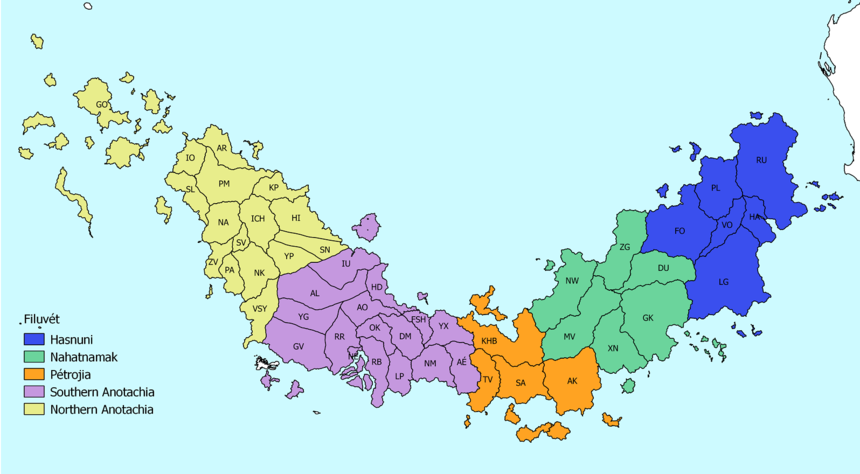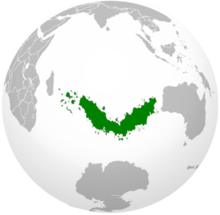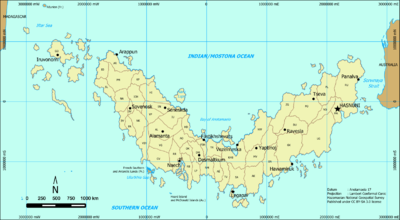Nation/Hazamaeia
| The United States and Provinces of Hazamaeia Ил Фэдэразъён дэл Эᴊдхизэ ᴊэ Киадвизэ дир Хазамаәиа
|
||||||
|---|---|---|---|---|---|---|
|
||||||
| Motto: Héjiy, Fordomin, Unterakhti (Hazam) Unity, Future Generations, Work |
||||||
| Anthem: Milanokari Hazamaeia | ||||||
Hazamaeia (green) in Nimtahé parallel with the Earth.
|
||||||
| Region | Islam | |||||
| Capital and largest city | Hasnuni | |||||
| Official languages | Hazam | |||||
| Demonym | Hazamaeian | |||||
| Government | Federal republic | |||||
| - | President | Lakhis Tavanni Entrenomolazaeia | ||||
| - | Vice-President | Induri Kivanovolagastanei | ||||
| - | Chairman of the CPE | Tryztven Revtradik | ||||
| Legislature | Council of Professors and Experts | |||||
| Establishment | ||||||
| - | Petrojian Confederacy | 32-5-17 Fentrau 10 | ||||
| - | Union of Sixteen Hazamaeian States | 154-21-64 Sembyansk 37 | ||||
| - | Republic of the Anotachian Provinces | 204-45-135 Sembyansk 34 | ||||
| - | Union of the Two Sister Nations | 349-10-32 Sembyansk 12 | ||||
| Area | ||||||
| - | Total | 3,983,450 km2 1,538,019 sq mi |
||||
| Population | ||||||
| - | 2010 census | 56,879,102 | ||||
| - | Density | 14/km2 36.3/sq mi |
||||
| GDP (nominal) | 2013 estimate | |||||
| - | Total | US$144.794 billion | ||||
| - | Per capita | US$2,545.64 | ||||
| Gini (2011) | 28.1 low |
|||||
| HDI (2011) | 0.771 high |
|||||
| Currency | Nal (₦) (HZN) |
|||||
| Time zone | WHST, CWHST, CEHST, EHST (UTC+4-+7) | |||||
| - | Summer (DST) | not observed (UTC+4-+7) | ||||
| Date format | yyyy mmmm dd, dddd | |||||
| Drives on the | left | |||||
| Calling code | +481 | |||||
| Internet TLD | .hz | |||||
The United States and Provinces of Hazamaeia (Hazam language: Ил Фэдэразъён дэл Эᴊдхизэ ᴊэ Киадвизэ дир Хазамаәиа, Fihanta transliteration: Il Fédéraz"yon dél Éjdhizé jé Kiadvizé dir Hazamaeia, literally means The Federated States and Provinces of Hazamaeia) is a federal country located in the Southern Mostona Ocean region of Nimtahé. Its hard-nosed, intelligent population of 56 million are fiercely patriotic and enjoy great social equality; they tend to view other, more capitalist countries as somewhat immoral and corrupt.
It is difficult to tell where the omnipresent, socially-minded government stops and the rest of society begins, but it juggles the competing demands of education, religion & spirituality, and law & order. It meets every day to discuss matters of state in the capital city of Hasnuni. The average income tax rate is 81%, and even higher for the wealthy. A powerhouse of a private sector is led by the tourism industry, followed by furniture restoration and uranium mining.
Crime is totally unknown, thanks to the all-pervasive police force and progressive social policies in education and welfare. Hazamaeia's national animal is the Hazamaeian Ibis, which frolics freely in the nation's many lush forests.
The isolationism ideology used by Hazamaeia making them one of the most isolated countries in the world. Lack of foreign affairs with other country has successfully secured Hazamaeia from wars, having no external war within the last 57 bicenturies of the Rahernw calendar (11400 years of common solar calendar used in Earth).
Contents
Etymology
The word hazama and antach used by the two nations of Hazamaeia and Anotachia who later federated to form the country is possibly derived from the Old Hazam language hazm and Kashvnet language antas, respectively, which both in turn may come from the Olyanivran word of hazmi and antas. These words are famously referred as the names of two great merchants, Hazmi and Antas, who are told in the Chronicles of Ntrikhum as the one who introduce Islam in the region. They are told to have come from the north part of the Mostona Ocean. Hazmi preached his teachings in the eastern region and later formed the standardized version of the Old Hasnunian language used in the Stadnawi Kingdom. King Antumua VI honored his work posthumously by giving the name of the standardized language, Hazamska (the language of Hazmi). The language is used in many official and administration activity in the kingdom and eventually became a lingua franca for both the east and the west. Meanwhile, Antas preached the western region and successfully managed the previously small city of Alamanta to become a major trade city in the Centrania Plains. He was viewed as the savior for the government of Alamanta and had his name immortalized as currency which later used throughout the west as the trade continued to grow.
Hazmi and Antas considered as a symbol of unity of the people in Hazamaeia. When the union of the two already established Hazamaeia and Anotachia was being processed, Hazamaeia was determined by a referendum among the people to be the name of the united country. Antas (Anotachia) still has his name as two high governorates of Northern Anotachia and Southern Anotachia, two of five high governorates in Hazamaeia.
History
Early settlement
The earliest known of records regarding human settlement in the land of Hazamaeia is the paintings at the Narindoa cave in the State of Movyunska which dates back to the -38th century of the Rahernw calendar. The paintings depict animals and human hunter all colored in red from mixing of dirt and animal blood. Ancient sites related to first community in Hazamaeia can be found in Rontawambé in the Province of Pardavanosk. Archeologists found many iron blades, pottery, human skeleton, and other tools which marked remains of once living village with stone houses dates back to the -30th century. Other ancient community sites can also be found in Laveston, Naharnawa; Kiawu, Kaparyn; Legapal; and even in the Gonostomaeia islands where stone inscriptions, stone wells, copper weapons, .and jewelries were found.
Ancient and classical era
First triumphant civilization that ever recorded in Hazamaeian history was the Ikhvivanindor Kingdom centered in the bank of Ikhvw River in what is now Province of Fastikhshévats. Ikhvivanindor reigned over much of southern part of the country from about -24th century until the -18th century. The decline of its power still unknown to historians. One theory from Achnawil Hitrinovsa, a Hazamaeian history professor from University of Panalava, suggests that the kingdom was devastated by the eruption of F'adremni Volcano in the middle of -18th century. The volcano located just southwest from the kingdom's capital. The eruption caused the capital to be buried until it was discovered by archeologists 708 centuries later. The stability in local provinces dropped since governors competed for the central power abandoned by the deceased royal family. Civil wars abrupt and the kingdom finally split into smaller kingdoms. This theory is supported by the findings of pottery and ancient tools which covered in volcanic dust and layer of lahars in Fastikhshévats.
Several kingdoms then existed throughout the country in the remaining of ancient and classical history of Hazamaeia. Famous example including the Ivprinoia Kingdom in central Dulmun, Panalava Kingdom in Runia, and Sonastig Kingdom in southeastern Ririnétta. The iconic one was probably the Anvrimna Kingdom which ruled much of the western part of the country from the -4th century until the 8th bicentury when the government was overtaken by coalition of rebels who brought local nationalism. The new government of Anvrimna then changed into the Confederation of Rakhipindya which included several republics led by the former rebels generals. The remains of the kingdom can be found mainly in the Province of Ichslapun and Aénaverlod where buildings like temple, palace, plazas, and classical style dwellings are generally still intact.
Medeival era
The Medeival era in Hazamaeia marked by the disestablishment of the Kingdom of Anvrimna in the establishment of several state like the Principality of Sovenosk in northern Anotachia, Alamanta Republic, Stadnawi Kingdom and Tséva Republic in northern Hazamaeia and the Confederation of Rakhipindya in most of the region of the former Anvrimna. The tales of Hazmi and Antas in the Chronicles of Ntrikhum, written by the famous poet Ili Pamandir, was possibly happened in the in this era at the 29th bicentury Rahernw.
The 31st bicentury of Rahernw saw the commencement of the Great War of All (Hazam: Moя Дуля, Moya Dulya). Hazamaeia was divided in three factions which is the Northern Allies (Nharnawa, Stadnawi, Tséva, Panalava, and Lugudia), the Central Axis (Rakhipindya, Knights of Légapal, and Diltaniir) and the Western Treaty (Alamanta, Vonosholo, and later Gonostos) warring each other. Cause of the Great War was the Ornivtaran Plague (Hazam: Тумсак Орнивтаран, Tumsak Ornivtaran), a smallpox plague emerged in Ornivtaran in southern Rakhipindya by the sudden coming of Satan's ibis from the southern sea. The bird spread disease and contaminated water throughout Hazamaeia. Nharnawa stated that the plague caused as God's punishment to the indifferent trade conducted by the Rakhipindyans merchants. Rakhipindya then accused Alamanta and Republic of Vonosholo, claimed that the plague is the consequent disaster since the two country never able to secure the land between them and Rakhipindya from caravan bandits and pirates. Vonosholo itself blamed Nharnawa about the mysterious plague with being neglect at the famine in Vonosholo 87 years earlier. All of misunderstanding and discontented by the insult, added with the difficulty of communicating between the sparsely located nations and the ongoing plague, led the three country formed alliance with their neighbor and declared war to each other.
Great War of All resulted in many casualties within the three sides by the war or the plague. All of the monarch/presidents of the belligerents died either by the plague or the war except one, Lindishtw Aihandtni, president of the Republic of Lugudia. Aihandtni decided to join the war to maintain relations with his neighbor countries but refused to send troops to the battlefield. Eight years after the war commenced, Aihandtni called to all of the nations to assemble in one room to just stop this "idiotic war" (as he quoted in the Duronun Lugudia sage). All the nations managed to sit in one room in a assembly hall in the city of Pétrojia. The meetings agreed upon a white peace to the war, with the Axis and Allies decided to hold a referendum for the creation of a confederacy while the Pact allowed to still be independent countries. The majority of the people in the Axis and Allies countries, exhausted by the war, voted "Yes" for the creation of a confederacy named Pétrojia hoping there wouldn't be another conflict in the land.
Renaissance until Hazamaeia today
The industrial revolution with the big advance in science and art resulted in the so called Anstropi era in Hazamaeia. The discovery in electricity, steam engine, flying machine, and agricultural engineering brought reformation to the country from the dark history.
The Petrojian Confederacy was peacefully dissolved when the Sixteen Hazamaeian States chose to withdraw from the confederacy and become an independent nation. The remaining provinces in the confederacy united with Alamanta, Vonosholo, and other western regions to form Anotachia several bicenturies later. Hazamaeia and Anotachia maintain good relations ever since and union was proposed by several societies and provincial/state delegates calling for a one sovereign nation in Southern Mostona. A referendum later was held to determine the establishment of the union and the name the union should take.
There was a big war however, after the establishment of Hazamaeia and Anotachia, the region was invaded from foreign forces from the north of Mostona called by the people as Yurukman. The two countries formed an alliance to fight the common enemy. The war was awful, with several region lost to the Yurukman but managed to be taken back. The two sides of the war signed a peace treaty 9 years after the war was commenced.
Politics
Hazamaeia is a federal country led by a president (мандатэри, mandatéri) and a vice president (нендй мандатэри, nyéndiy mandatéri) elected every 4 years by the Council of Professors and Experts (CPE, Минтаԛати дир Ахтинум, Mintaqati dir Ahtinum, МДА) which consisted of state-recognized experts in many discipline of studies, mainly social and natural sciences. The council is also responsible of the legislative power. The judicial power is held by the Supreme Court and the Constitutional Court.
States and provinces in Hazamaeia have their own governor (атиум, atium) elected by the the State Assembly or the Provincial Assembly (Минтаԛати дир Эᴊдхи, Mintaqati dir Éjdhi; Минтаԛати дир Киадви, Mintaqati dir Kiadvi) and the legal power is held by the Court of the People (Махкамах дир Манувэ Mahkamah dir Manuvé).
Administrative divisions
Hazamaeian federation is consisted of sixteen "states" (эᴊдхизэ, éjdhizé) and thirty-two "provinces" (киадвизэ, kiadvizé). The difference between the two form of region is that states are more autonomous than provinces. States can manage their own budget over several things including road network funding and water management and engineering which not controlled directly by the federal government except for the provinces. States have their own rule over several local legal products such as trash burning prohibition law and no swimming in reservoir act. The same law may also be had by several provinces but if it is either determined by the High Governorate Council or the federal government or only as a provincial law. States can 'protect' themselves from federal law by establishing their own law on the same subject but the case is rare. Provinces and states are further divided into counties (гэхвэхзэ, géhvéhzé) and cities (кромизэ, kromizé) and districts (каᴊиматамзэ, kajimatamzé).
In addition to the states and provinces, Hazamaeia is divided into five high governorates (филувэтзэ, filuvétzé). These high governorates comprise several states or provinces to manage multiregional administration, needs, and affairs.
The administrative divisions of Hazamaeia is enlisted as the following:

Geography
The Hazamaeian landmass is located in the southern Mostona Ocean which parallels with the Indian Ocean in Earth between 50°E-115°E and 23°S-56°S. Interdimensional portals in the Mostona allows transportation, navigation and connectivity with the rest the Earth and the rest of the Universe. Hazamaeia is a borderless country which has no land border with any other nation. It has maritime borders though, including with Australia on the east and several French Southern and Antarctic Lands like the Kerguelen Island near the West Fortkhia Island.
Hazamaeia comprises a total area of 3,983,450 km². The mainland (continent) of Anotamaeia is at 3,605,056 km². Several islands exist around the Anotamaeian landmass including Fortkhia Islands, Kiruv Islands and the largest, Gonostomaeian Archipelago. The average population density is at 14 people per square kilometer (36.3 per sq mi), so much land to be spared that many parts of the country are uninhabited woods, mountains and meadow. The highest point in Hazamaeia is the peak of Mount Indwhaywm at 5,660 meters asl in the Mimzanamarus Mountains. The longest river is the Sijstorimdya River which flows through more than 5 provinces.
Hazamaeian landmass was formed by volcanic and geologic activity in millions of year. Ornivar Plate in the south is colliding with the Karipvuna Plate in the north which has lighter density and caused the Ornivar to slide down below Karipvuna, disturbing the lava layer and creating several volcanoes in the middle part of the landmass. Volcanoes ranges then were built up and might rise more than 5600 meters above sea level. Many of the volcanoes are now dead but some still show their activity such as Kyrlar Volcano in Dulmun and the highest active volcano in Hazamaeia, the Ardunar in Nokadima.
Much of the country lies below the Tropic of Capricorn thus giving the country a mild to medium temperate climate. Exception is for a little part in the northern island of Iftar which has a sub-tropical climate and is used for the vanilla industry throughout the island.
Biota and environment
Hazamaeia is mostly covered by temperate rainforest and open terrain like grassland or plains. Plant species such as pine and casuarina are common while common faunas include some mammals like horse, hare and elk and also aves such as Bondol eagle. Some main fresh-water fish including the pangasius while salt-water creatures like humpback whale, dolphin, and herring are also found. Reptiles including the Gonostomaeian phyton and monitor lizards.
Hazamaeian habitat is also home for several endemic species which some are protected by the Hazamaeian law. Protected species include the Tavannur leopard and the national animal, Hazamaeian ibis. Both population trend are declining due to deforestation since about 400 years ago. The government took the step to make a law that prohibits the hunting of protected species and also to construct several reserve and national parks throughout the country.
Environmental issues become one of government's concern particulary after the turnout of the 21st century. Hazamaeia began to close many of its coal power plant and plan to build several dams and windfields throughout its territory. The series of policies concerning about the environment from Hazamaeian government is commonly called as the Green Work Project (Hazam language: Сәафй Унтәраӽти Проекта). By the end of 2013 (351-5-16 R), the project has managed to build 5 new dams and construct 1 new national park and 2 new nature reserve.
Demography
According to the 2010 census, Hazamaeia is inhabited with 56,879,102 people thus having a very low population density at 14 people/km². Most of them lives in rural areas and work as a farmer. Hazamaeia's capital and biggest city, Hasnuni, is populated with around 3 million people. Many Hazamaeians are traditionally demographically pessimist and they tend to have only one ore two children with their spouse. The government has planned to increase the number of the population into around 80 million by 2020 (351-7-23 R).
There are many ethnic groups speaking various languages in Hazamaeia. However, the official language of the country is the Hazam language which is the native language of the Hasnunian people. Other ethnic groups including the Olyanivran, Thrahingian, Centranian, Gonostese, Rantipadnawese, Rwnian and Legapalese. Minority people includes people in the islands of Kiruv, Aéna and Fortkhia. Many of the ethnic groups have their own language like the Olyanivran people mainly speak the Olyanivran language. Dialects of these languages vary between regions.
Main writing system which is used in Hazamaeia is the Hazamaiean Cyrillic taught by disciples of Antas Kiadmeuna and Hazmi Kiadmeuna. The script contains 45 distinct letters, two of which don't have the uppercase counterpart (the ъ and ѝ letter). Sound ranges from normal "a" and "p" to soft whistling and combined r-l sound.
According to the 2010 census, around 94% of the population identify themselves as a Muslim. Islam was brought to the country at around 800 AD (middle ages of Rahernw) by Arabic, Persian and Indian traders from north through the inter-dimensional portals. Another part of the society adhere Christianity which was brought mainly by Portuguese and English mission. Judaism spread at the era of Earth's World War II and the adherent is mainly consisted of European Jewish refugees. Buddhism and Confucianism are mainly practiced by Chinese descendants while old traditional beliefs still exist like the Aruhna.
Military
Hazamaeian military consists of the Army (Ritéaréa), the Navy (Suluemréa) and the Air Force (Latiréa). Hazamaeia spends around 10% of its national budget in the military. Along with the police force, the military is under the control of the Ministry of Defense.
The weapons used by the military varies between the modern and traditional technology. Rocket artillery and armor vehicles are both used, as well as crossbows and pikes.
Economy
The country's nominal 2013 GDP estimate is at US$144.794 billion. The country's main export commodity is agricultural products. It makes about 60% of the GDP in 2013. Trade with various international companies also focuses on agricultural products ranging from rice and wheat grain into cheese and halal sausages. Another 28% of the 2013 GDP comes from oil, gas and mining industries of various minerals and metals including bauxite and cobalt. The rest is mainly comes from tourism.
Hazamaeians are traditionally an agrarian society. More than 50% people work in the agricultural sectors at the 2010 census. 38% others work in manufacturing mainly in food processing. The rest is in the service industry ranging from tourism, civil service, and education. The Hazamaeian nal (₦) is used as the national currency whose value is roughly at 1 dollar per 2 nals.
Transportation
Transportation structure in Hazamaeia can be categorized to four elements which are road network, railway network, seaports, and airports. Roads are mainly covered with ashpalt in big cities but they are oftenly bare dirt in countryside. This relates with the policy that prohibits private-owned motor vehicles in the country. People usually take public transportation like metro and trains, including when going to sell their agriculture products. Train is also main land transportation mean in Hazamaeia with only 2 state/province capital which are not connected with rail to the capital (Iruvonomi in Gonostomaeia and Legapal in Sorannai). Sea transport is the most important international connection in Hazamaeia, particulary in exporting. Many cities lies on shore with their own ports. Hasnuni as the capital having the biggest. Few location in Hazamaeia has an airport, the government already planned to build more particularly in isolated islands in Gonostomaeia province to cut travel time between islands.
Culture

Hazamaeian ethnic groups carry their own cultural values and tradition. Most common culture symbol in Hazamaeia is the rice. Rice plays an important part as the primary food for many Hazamaeians. It is regarded as the symbol of life, wealth, as well as fertility. Another symbol is the Arabic letter Lam Alif which is depicted in the country's flag. Lam Alif is the traditional symbol of love, pacifism, and isolationism value in Hazamaeia. For about 10,000 years of its history, Hazamaeia covers itself from any diplomatic relation with other country in order to be secure after the Yurukman War. The Lam Alif (pronounced la) means "no" in Arabic, thus representing Hazamaeia rejection to outside world. The country is now slowly recovering though, some relation hace been conducted with other countries.
Popular sports in Hazamaeia include curling, handball, archery, and rowing. To a lesser extent, Biathlon and other forms of skiing are also popular as well as volleyball, rugby union, and badminton. In its first Olympic participation at the IX Olympic Winter Games, Hazamaeian team manage to win 1 gold and 1 silver from nordic comined and alpine skiing, respectively.
Hazamaeian gastronomy focuses mainly on rice as the symbol of life. Rice is commonly eaten by Hazamaeians plain, with some spices and an egg, called kutzum. Kutzum may be fried and added with spices and meat to form syuliy kutzum (similar to fried rice) oftenly eaten with arukh and pickles. Another popular delicacy is tunaw luhuta which is boiled vegetables (yardlong bean, cabbage, carrot, and green cherry tomato) with istunétza (Averrhoa bilimbi), maize and other spices, oftenly eaten with rice, fried satun (tempeh), tofu, fried fish, and asymin (sambal). A variant of tunaw luhuta is called koszjétna luhuta whose ingredients are different adding eggplant, red bean, gnetum leaf, red tomato, and tamarind. Famous other dishes including rajitmilan (vegetables with crushed peanut), rosturén (fried dumplings with crushed peanut) and fried noodle. Drinks examples include uda and orumak (apple dipped in orange juice).
Song, dance and traditional poetry are another products of Hazamaeian culture. Traditional songs involve singing and playing of flute and langutang while the dance is oftenly contemporary but also following the music rhytm. Another singing involves lyrics which is derived from traditional rhytmic poem (olimsa). Modern literature form includes novel and contemporary poem. Famous Hazamaeian writer example is Arekh Undawtisaluva with his famous novel Arturan of the South.
External links
- NationStates - Hazamaeia
- Hazamaeian Embassy and Consulate Program - Ministry of Foreign Affairs
| ||||||||||||||||||||||||||||||||||||||||||||||||||||||||||||||||
| ||||||||||||||||||||||||






